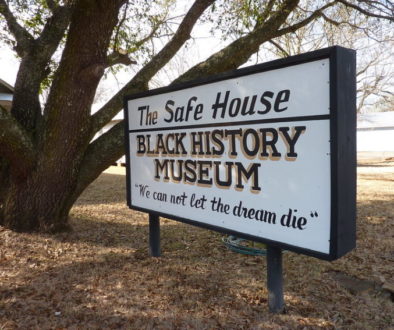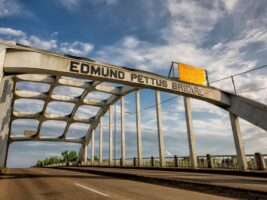
Before 1965, the world had never heard of Selma.
But in March that year, it became known around the world as a place of protest, marches and savage police beatings on what is now called Bloody Sunday.
There are plenty of things to do in Selma. Every tour must include a walk across the bridge, which I once called the most beautiful place in America. The experience is deeply moving, having the power to literally put you in the footsteps of the protesters. When you reach the top, pause. Look across the river and imagine you’re facing a phalanx of law officers with riot gear and billy clubs, whips, horses and tear gas.
Ask yourself, what would I have done?
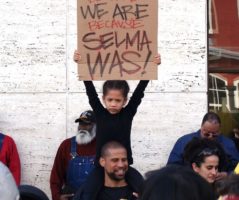
There’s a reason Presidential candidates make a point of visiting Selma for the annual Bridge Walk, a community celebration every March that marks the events that happened here. If you’re traveling at that period, it’s worth attending, although it will complicate trip planning because of crowds and limited availability of hotel rooms in the city.
In many ways, Selma was the apex of the Civil Rights movement. The brutality and the march to Montgomery that followed shocked the nation and led directly to the passage of the national Voting Rights Act.
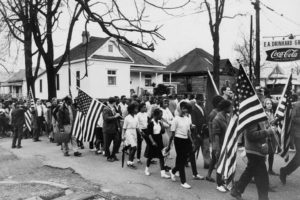
Selma tour: Plan ahead
Today Selma is small, sleepy Southern town. The first challenge is getting to the small central Alabama city, which even now feels isolated, miles from any interstate. There are also limited restaurants and hotels in Selma, so it’s important to plan ahead.
It’s a good two-hours’ drive from Birmingham, or nearly an hour from Montgomery. From Atlanta, allow three.
But once here, you’ll find yourself in the center of the movement. The most striking sight is the Edmund Pettus Bridge. Even if you’ve never set foot in Alabama before, the span will look eerily familiar from news coverage and documentaries. It’s such an important landmark that the crew for the movie Selma came to town to stage the crucial bridge crossing scene, while most the rest of the movie was made in Georgia.
A visitor can at most spend a few hours here, passing by the churches where the marches were organized, stopping by the National Park Service visitors center, and walking the bridge.
Other stops include the National Voting Rights Museum, and the Civil Rights Memorial Park. Although it’s not on many tours, the Old Depot Museum’s Civil Rights Room is worth a brief stop to see the hospital logs recording the injuries of marchers on Bloody Sunday.
If you are with a group, consider hiring local guide Joanne Bland, who participated in the Bloody Sunday march. Her account of that horrifying day is riveting, and makes the history come alive. And Terry Chestnut’s tours frequently meet with local officials and former foot soldiers.
This post will cover the sites in Selma itself. We offer a guide to driving the Selma-to-Montgomery trail separately.
| If you’re traveling to Atlanta, and want to visit Alabama’s most important civil rights sites, you can see them all in a day on a unique package trip. A marathon 12-hour tour with a driver/guide will visit the landmarks in Birmingham, Selma, Montgomery and Tuskegee. |
Setting the stage
The small city on the Alabama River found minor fame as a supply center and battleground during the Civil War, but for the most part, it was a forgotten backwater. All that changed after the February, 1965 murder of Jimmie Lee Jackson by the Alabama State Police. Jackson was a resident of Marion, which is 27 miles away. Some may want to make the trip to see the site of the shooting, and his grave outside of town.
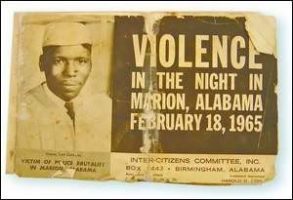 King, it’s worth noting, knew the area well because his wife, Coretta Scott was from Marion, and he was married in the small town. Her home and the family grocery store is noted with an historic marker.
King, it’s worth noting, knew the area well because his wife, Coretta Scott was from Marion, and he was married in the small town. Her home and the family grocery store is noted with an historic marker.
Selma itself was run by a ruthless sheriff Jim Clark, who suppressed any attempt to register Black citizens to vote. In 1964 the city had been visited by hundreds of volunteers from SNCC (the Student Nonviolent Coordinating Committee). By some measures only 300 of the city’s 15,000 potential Black voters were registered.
Clark formed a posse of Ku Klux Klan members and resisted the registration drive during 1964. Following Jackson’s death, attention turned again to the Selma. King and others were drawn to the city, and many mass meetings were held along what is now Martin Luther King Jr. Street, formerly Sylvan Street.
After Jackson’s murder, James Bevel, a leader of the Southern Christian Leadership Council, called for a peaceful march to 50 Montgomery, the state capital located about 50 miles east of Selma along Highway U.S. 80.
But it wouldn’t happen without a fight.
National Park Service Interpretive Center
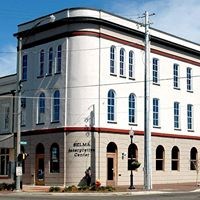
The federal National Park Service visitor center makes a good stop to get oriented. It’s located at 2 Broad Street, across the street from the Edmund Pettus Bridge, which carries U.S. 80 across the Alabama River.
Inside you’ll find exhibits, historic photos, maps and helpful park rangers. It’s a good place to make a bathroom stop, get a drink of water and plan your visit. It has a small bookstore and gift shop.
As you enter the center, notice the figure behind the desk at the entrance. In the video below, a park ranger explains the significance. The figure represents a voting registrar and the props on his desk illustrate the challenges blacks faced when trying to register to vote. That explains the big jar of jelly beans. A registrar might ask a potential voter to tell him the number of jelly beans. And look for soap. Another question asked was the number of bubbles in a bar of soap. Those were the first hurdle before anyone could even take the required 68-question literacy test of Black voters.
Lead up to Bloody Sunday
On March 7, 1965, about 600 protesters led by SCLC’s Hosea Williams and SNCC’s John Lewis left Brown Chapel to march to the bridge. Alabama Governor George Wallace had banned the protest, and the marchers were ordered to stop.
They paused briefly, but continued to advance. And then the attack started. State troopers rushed to the marchers swinging billy clubs. Lewis fell to the ground with a cracked skull. Sheriff Jim Clark’s posse fired tear gas, swung bull whips and rubber tubing wrapped in barbed wire. White crowds cheered on the attack.
The nation was horrified when images of the violence aired on national television that evening, and in the days that followed marchers from around the country began to descend on Selma. Hundreds of clergy came from around the nation, including the Rev. Abraham Akaka, who brought floral leis from Hawaii, and noted Rabbi Abraham Joshua Heschel.
Two days later, on March 9, Martin Luther King, Jr., led a march to the bridge, stopping at the top to pray, but because the march was still outlawed, he stopped, and marchers returned to Selma. This became known as “Turnaround Tuesday.”
Shortly after that day’s march, the Rev. Jim Reeb, a Unitarian minister who had rushed to Selma from Boston to support the march, was attacked on a side street in Selma, He died two days later in Birmingham from head injuries.
A monument outside the Old Depot Museum honors his memory. The museum is worth a stop for its Civil Rights Room, which contains the hospital log of the Good Samaritan Hospital, which records the death of Jimmie Lee Jackson and the treatment of marchers injured on Bloody Sunday.
For a deep dive into Reeb’s murder, download the seven-part NPR podcast White Lies, about the search for his murderers decades later.
Finally two week later on March 21, the protest ban was overturned by U.S. federal judge Frank M. Johnson, Jr. The march to Montgomery was allowed to proceed.
While in town, note the Dallas County Courthouse, 105 Lauderdale St., 36701 where Sheriff Jim Clark ruled the town. The building was a flashpoint because it was here that African-Americans were consistently refused the right to register to vote.
The churches of Martin Luther King Jr. Street
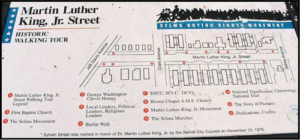
Selma’s black community focused on Sylvan Street, which was home to its most important churches. The street’s name was later changed to honor Martin Luther King, and it’s worth taking a drive or walk down the boulevard. In 1965, this was the center of all the action.
Important stops include Brown Chapel AME Church, where the march was organized and began, shown below. Tours are by appointment, and can be arranged through Joyce O’Neal
(334) 875-3112 or (334) 505-9779, brownchapel.selma@gmail.com
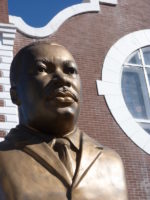
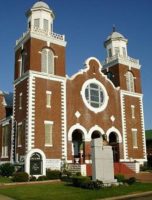
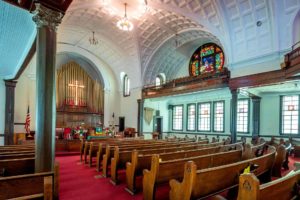
Nearby, the First Baptist Church was the home of Selma voting rights campaign organized by SNCC, and King spoke here several times as well. Remember that the civil rights movement was not run by a single organization. King’s Southern Christian Leadership Council (SCLC) was one of many groups who were pushing for civil rights, and there were often rivalries between the organizations.
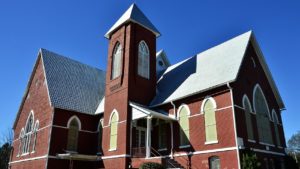
Crossing the bridge: following the footsteps of history
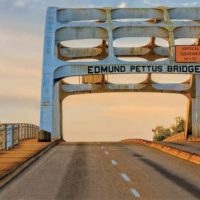
Don’t feel shy about walking across the bridge. It’s a simple, but powerful act that literally puts you in the footsteps of history. Visitors make the crossing every day.
It’s worth noting that the bridge is named for a former Confederate officer. Edmund Pettus later became an influential politician, serving in the U.S. Senate, and also as Grand Dragon in the Ku Klux Klan. It might seem ironic that his name’s associated with a signature moment in the civil rights, but in the South, such contradictions are literally part of the landscape.
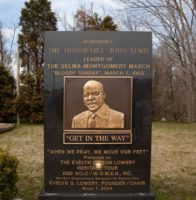
As you reach the high point of the bridge, stop and look ahead to the eastern landing. Imagine what you would do if you had been marching on March 7, 1965. Ahead of you waited police and troops on horseback.
Would you have had the courage to keep walking, knowing what awaited?
Once you reach the eastern side, stop by the Civil Rights Memorial Park on the left, where monuments remember the protesters and trails lead through woods with Spanish moss.
Betty Strong Boynton Interview Selma, AL from U.S. Civil Rights Trail on Vimeo.
Across the bridge: National Voting Rights Museum
After crossing the bridge, plan a visit to the National Voting Rights Museum and Institute, which displays artifacts from the voting rights campaign, starting from before the marches and to the present.
The museum includes pictures taken at the protest, and exhibits chronicling the history of race relations in Alabama.
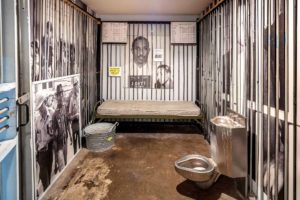
If you find the Klan robes unsettling, imagine what it would be like to see them in the middle of the night.
Among the most compelling images are photos taken by the Alabama State Police documenting the march and the violence. They’re now on display in the gallery.
Also of interest are exhibits about other key moments in the civil rights movement, including less-known campaigns in Albany, Georgia and St. Augustine, Florida.
This is a community-run museum and hours vary. Please call ahead, 334-526-4340, to make sure the doors will be open when you’re in town.
Guidebook
Legendary local tour guide Joanne Bland
And if you’re in Atlanta, and want to visit Alabama’s civil rights sites, you can take a 12-hour tour with transportation that will take in key landmarks in Birmingham, Selma, Montgomery and Tuskegee.
Restaurants
The Coffee Shoppe This once-segregated diner is now Black-owned. (Its always busy drive-through was once used to serve African-Americans, who weren’t allowed inside.) Conveniently located a short walk from the Pettus Bridge, it’s a perfect stop for scones, sandwiches and, of course, coffee.
Downtowner A down-home favorite. Try the biscuits and gravy, and the peach cobbler. Open for breakfast and lunch, 1114 Selma Avenue, 334/875-5933
Lannie’s Bar-B-Q Spot Classic Southern favorites at this third-generation eatery in the Black Tuxedo Park, where mac and cheese counts as a vegetable. A highlight: smoked pulled pork, topped with cracklings. 2115 Minter Ave. 334/874-4478
Hancock’s Country Bar-B-Que Located about five miles west of town, it’s worth the trip for legendary hickory-and-pecan-smoked barbecue. 72 Co Rd 46, Selma, 334/872-5541.
Tally-Ho An old-school steakhouse. 509 Mangum Avenue, Selma. 334/875-1390
Selma Hotels
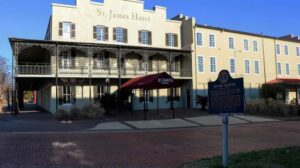
Selma is a small town, and if you’re staying overnight, it’s important to book ahead. Except for the St. James, most its offerings are chain motels, which cluster along Highland Avenue (US 80), about two miles from the Pettus Bridge. Here are your best options:
The St. James Hotel This historic inn has by far the best location overlooking the Alabama River, and has just re-opened after a spiffy upgrade. If your budget allows, you won’t regret it. Book here.
Hampton Inn Selma A top-rated property with pool and free breakfast.
Holiday Inn Express Hotel & Suites Located next to the Hampton and at a similar price point, you’ll find a pool and smoke-free rooms.
Quality Inn Selma A little less fancy, but still offers more than the basics, with a gym, pool and business center.
Comfort Inn Like the Quality Inn, you’ll get the basics, but still a clean, well-managed place to spend the night.
Great Selma AirBnB options
Although the hotel scene isn’t inspiring, Selma does have a nice collection of AirBnbs in a century-old renovated downtown building.
The five light-filled Woolworth Lofts are the most stylish places to stay in the city, with preserved stained-glass window accents, Keurig coffee makers, and coffee table books highlighting the region. The only drawback is the flight of stairs which would pose a challenge to travelers using a wheelchair.
The biggest loft, Studio B, has two bedrooms and two baths, and can sleep six. Studio A and Studio F sleep four, while Studio C and Studio E sleep two.
Also, consider the Bridge Tender House, an 1884 Victorian one-bedroom cottage that literally overlooks the Edmund Pettus Bridge.
Another option: Stay in Montgomery or Birmingham
Many travelers find it easiest to stay in Montgomery or Birmingham, and then visit Selma while they’re traveling between those two cities. Here are some hotel options in those cities.
Montgomery
About an hour away, Montgomery is a great bet for lodging, especially since you’ll probably be visiting the city anyway. But lodging can be tight here during special events and when the Alabama legislature’s in session. Here are a few options:
Trilogy Hotel One of the city’s newest lodgings is one of its best. Located walking distance from downtown civil rights sites, the hotel offers comfortable room in beautifully restored warehouses. 108 Coosa Street, Montgomery, 334/440-3550.
Springhill Suites A handsome and comfortable hotel set inside a renovated building, just a few blocks from the Legacy Museum. 152 Coosa Street, Montgomery, 334/245-2088.
Renaissance Montgomery It’s one of the city’s busiest and biggest hotels, and most comfortable. Near the riverfront park and convention center, and walking distance to most sites. 201 Tallapoosa Street, Montgomery, 334/481-5000.
Red Bluff Cottage Bed and Breakfast For real Southern hospitality, try something homier. This five bedroom B&B features antiques and wireless Internet. 551 Clay Street, Montgomery, 334/264-0056.
Dwella at Kress on Dexter A newly opened condo hotel within walking distance of the major civil rights sites.
Literature lovers, English majors and fans of The Great Gatsby can sleep in the former home of author F. Scott Fitzgerald. Two AirBnBs, located in the home Fitzgerald shared with his wife in 1931-32, include a record player with jazz albums and a sun porch overlooking the city’s Old Cloverdale neighborhood. Check out the Zelda Suite and the Scott Suite, which include a record player with jazz albums and a sun porch overlooking the city’s Old Cloverdale neighborhood.
Birmingham
The state’s largest city can see traffic backups at rush hour, so allow about two hours for travel between Selma and Birmingham. Here are some good options:
Elyton Hotel This newly renovated hotel occupies a former bank building, and has quickly become one of the city’s top places to stay. Its rooftop bar is a favorite with locals and visitors alike.
The Tutwiler – Hampton Inn & Suites Birmingham-Downtown Don’t be fooled by the chain affiliation, this is a Birmingham institution, refurbished and updated for guests. Don’t miss the free chocolate chip cookies at night.
Aloft Birmingham Soho Square Technically located “over the mountain” in the city of Homewood, this trendy chain offers basic, but stylish amenities.
One of the newest area lodgings, The Valley Hotel in Homewood, has a terrace bar, restaurants and public art.




